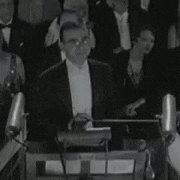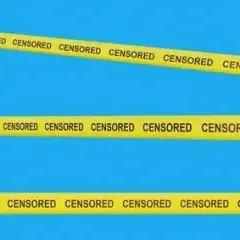
ETMuz
-
Posts
13 -
Joined
-
Last visited
Reputation Activity
-
 ETMuz got a reaction from Fabulin in Diagnosing harm
ETMuz got a reaction from Fabulin in Diagnosing harm
I could be wrong but what I understood what he meant by parallel is that the first Tri-tone comes in at 3:07 with the notes Eb and A - then moves up at 3:11 to Ab and D, then moves up a whole step to Bb and E then back down a whole step. Then down a half step then back up a half step. Keeping the distance with those two notes a tri-tone away.
that may not be what he meant but that’s the way I took it.
-
 ETMuz reacted to Falstaft in Diagnosing harm
ETMuz reacted to Falstaft in Diagnosing harm
This is a great question, @ETMuz. Our access to Williams's sketches is limited -- even in this era of score scans and leaks. But from what we have seen, Williams writes out everything meticulously, including full chord-voicings. The exception, as @Datameister says, is instruments within source cues where chord symbols are idiomatically appropriate -- the guitar parts in the Canto Bight in TLJ & revised Victory Celebration in ROTJ, or the source cues from Superman come to mind. In those cases though, the harmony tends to be pretty simple and therefore easy to translate into chord symbols.
Most of JW's pitch design is considerably more complex than this, and often either not strictly tertian or highly linear in nature. Figured bass would be useful in some cases, sure, but that system has its own advantages and disadvantages. The richness off Williams's harmonic vocabulary creates an interesting challenge when trying to account for his sonorities with simple labels. It's something I confront regularly with my thematic reductions.
Here's a few illustrative cases that I grappled with from Indiana Jones.
Sometimes there's no ambiguity, and chord symbols work just fine, like with the Medallion theme:
Sometimes the chordal language is clear but the bass-line or an internal countermelody is sufficiently independent to warrant depiction in spots too, like with TLC Nazi theme:
Sometimes one can boil a dissonant chord down to a technically accurate but rather unsatisfying or non-definitive chord symbol, like with the [C#-E-A-C-D#-G#] pentachord that undergirds Panama Hat's motif. An alternative label could be a polychordal Ab | A/C#, I suppose. Really, the best way to understand it is an A-minor chord sandwiched between a bass Db and melodic Ab, with a spicy D# lurking in the middle.
Williams's penchant for quartal and/or sus-chord harmonizations can really scramble chord symbol notation too, like with this auxiliary motif from TLC:
And then sometimes, the music is so dissonant or manifestly non-tertian that I throw up my hands and just put in the needed chord tones in the reduction. Chord symbols were never designed to deal with music like the B-section of Call of the Crystal, for example:
Incidentally, if this kind of stuff interests you, the piano album for Saving Private Ryan might be a worthwhile purchase: unusually for these sorts of reduced scores, it includes chord symbols for pretty much everything except the most irreducibly linear moments, and it contains essentially the entire score minus a single cue.
-
 ETMuz reacted to Datameister in Diagnosing harm
ETMuz reacted to Datameister in Diagnosing harm
Williams' sketches and scores don't normally use any sort of chord notation unless it's idiomatic for the music being written - if there's guitar in the score, for instance, you can bet there will be chords written in. Nothing fancy, just the normal sorts of chord notations you'd find in any lead sheet. But for traditional orchestral scoring, no, there usually isn't a need to write in the chord symbols...and as you've noticed, it can be quite difficult to describe some of his harmonies this way anyhow.
-
 ETMuz got a reaction from Falstaft in Diagnosing harm
ETMuz got a reaction from Falstaft in Diagnosing harm
I have enjoyed learning from alot of you JWFanners here. I don't post much but I am a lover of harmonically rich music. I have spent my last 6 or 7 years or so trying come up with the best system of understanding exactly what I am hearing(such as minor 7(b5) etc. That is why I try to diagnose music that I love. I understand harm in a deeper way when I hear the quality of the chord symbol I am looking at. I love big rich chords which is what drew me to JW many years ago. I remember hearing his work and knowing that this dude can play some piano I know! I still struggle sometimes knowing exactly what to call certain chords as it may not be as simple as C7(#11). I guess I am just more used to playing jazz than understanding how the classical analyzers look at things. My question is do you think that Mr. Williams ever puts down chord qualities in his sketches? atleast in the early part of his creations? Or do you think its all notation writing as he is doing it? I have seen a John Powell score where he had the chord quality in the music and I really enjoyed looking at it one time through like that. Just wondering how many of you are like I am and do you have your own system of diagnosing complex chords? I am currently about to start Music Theory III and I am trying to figure out how much I need to dive into figured bass or if thats not the way to go to analyze someone complex like williams.
Really sorry if my post if unfocused. I love this topic and there is not a more interesting mind to try to figure out than that of John Towner in my book.
Daniel
-
 ETMuz got a reaction from Jurassic Shark in Diagnosing harm
ETMuz got a reaction from Jurassic Shark in Diagnosing harm
I have enjoyed learning from alot of you JWFanners here. I don't post much but I am a lover of harmonically rich music. I have spent my last 6 or 7 years or so trying come up with the best system of understanding exactly what I am hearing(such as minor 7(b5) etc. That is why I try to diagnose music that I love. I understand harm in a deeper way when I hear the quality of the chord symbol I am looking at. I love big rich chords which is what drew me to JW many years ago. I remember hearing his work and knowing that this dude can play some piano I know! I still struggle sometimes knowing exactly what to call certain chords as it may not be as simple as C7(#11). I guess I am just more used to playing jazz than understanding how the classical analyzers look at things. My question is do you think that Mr. Williams ever puts down chord qualities in his sketches? atleast in the early part of his creations? Or do you think its all notation writing as he is doing it? I have seen a John Powell score where he had the chord quality in the music and I really enjoyed looking at it one time through like that. Just wondering how many of you are like I am and do you have your own system of diagnosing complex chords? I am currently about to start Music Theory III and I am trying to figure out how much I need to dive into figured bass or if thats not the way to go to analyze someone complex like williams.
Really sorry if my post if unfocused. I love this topic and there is not a more interesting mind to try to figure out than that of John Towner in my book.
Daniel



